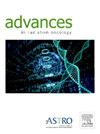舌骨放射性骨坏死:系统综述
IF 2.7
Q3 ONCOLOGY
引用次数: 0
摘要
目的:骨放射性坏死(ORN)是头颈癌放疗后的严重并发症,通常影响下颌骨,但对舌骨的影响知之甚少。方法和材料通过PubMed和Scopus进行文献综述,确定了16篇相关文章。强调了患者的特征、表现、影像学表现、管理和结果。结果本组共发现舌骨ORN 40例,平均年龄60.0岁。男性居多(87.5%),口咽肿瘤居多(77.5%)。平均放疗剂量为66.2 Gy,通常在放疗后27.6个月发生ORN。与仅接受放疗的患者相比,同时接受放疗和化疗的患者更有可能需要手术(80% vs 30%, P = 0.0042)。结论舌骨ORN虽然罕见,但随着口咽癌发病率的增加,可能会变得越来越常见。临床医生应该意识到出现的症状和可能的并发症,并熟悉彻底的检查和治疗。本文章由计算机程序翻译,如有差异,请以英文原文为准。
Osteoradionecrosis of the Hyoid Bone: A Systematic Review
Purpose
Osteoradionecrosis (ORN) is a serious complication following radiation therapy (RT) for head and neck cancers, commonly affecting the mandible, but is less understood when involving the hyoid bone.
Methods and Materials
A literature review through PubMed and Scopus identified 16 relevant articles. Patient characteristics, presentation, imaging findings, management, and outcomes are highlighted.
Results
The review found 40 cases of hyoid bone ORN, with an average patient age of 60.0 years. Most patients were male (87.5%) and had oropharyngeal tumors (77.5%). The average RT dose was 66.2 Gy, and ORN typically developed 27.6 months after RT. Patients receiving concurrent radiation and chemotherapy were more likely to need surgery compared with those treated with RT alone (80% vs 30%, P = .0042).
Conclusions
While rare, hyoid bone ORN may become more common with increasing rates of oropharyngeal cancers. Clinicians should be aware of presenting symptoms and possible complications and be familiar with a thorough work-up and treatment.
求助全文
通过发布文献求助,成功后即可免费获取论文全文。
去求助
来源期刊

Advances in Radiation Oncology
Medicine-Radiology, Nuclear Medicine and Imaging
CiteScore
4.60
自引率
4.30%
发文量
208
审稿时长
98 days
期刊介绍:
The purpose of Advances is to provide information for clinicians who use radiation therapy by publishing: Clinical trial reports and reanalyses. Basic science original reports. Manuscripts examining health services research, comparative and cost effectiveness research, and systematic reviews. Case reports documenting unusual problems and solutions. High quality multi and single institutional series, as well as other novel retrospective hypothesis generating series. Timely critical reviews on important topics in radiation oncology, such as side effects. Articles reporting the natural history of disease and patterns of failure, particularly as they relate to treatment volume delineation. Articles on safety and quality in radiation therapy. Essays on clinical experience. Articles on practice transformation in radiation oncology, in particular: Aspects of health policy that may impact the future practice of radiation oncology. How information technology, such as data analytics and systems innovations, will change radiation oncology practice. Articles on imaging as they relate to radiation therapy treatment.
 求助内容:
求助内容: 应助结果提醒方式:
应助结果提醒方式:


